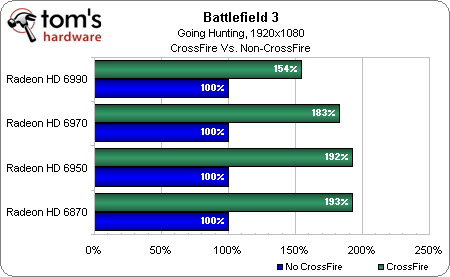Battlefield 3 Performance: 30+ Graphics Cards, Benchmarked
Are you wondering how your PC will handle Battlefield 3 before buying the game? We pulled a series of all-nighters to get almost every graphics card in our lab tested, in addition to a handful of processors, to answer your performance-oriented questions.
Benchmark Results: AMD Graphics Cards, CrossFire
The most frustrating part of putting this comparison together was spending a full day troubleshooting AMD’s multi-GPU issues. After swapping out power supplies, graphics cards, SSDs, fresh Windows installations, and motherboard slots, there was simply no rhyme or reason to the number of problems that prevented me from running a dual-GPU card or two single-GPU boards. Then came the idea to trade out memory kits, which actually ended up ameliorating some of my woes. Instead of crashing upon launching the game, CrossFire-based setups crashed when I changed settings at the end of the run or when I’d load up a level.
After a long night of restarting Battlefield 3 after every resolution change, I finally had results for four different card combinations: two 6990s (quad-GPU, yay), 6970s, 6950s, and 6870s.
The Radeon HD 6990s are absolute beasts, pegging this game at its 200 FPS limit at 1680x1050 and 1920x1080. It naturally scales poorly at those resolutions because it simply cannot go any faster. At 2560x1600, however, two additional GPUs contribute an extra 90%.
Scaling amongst the other cards ranges from 83% to 97%, which is really quite phenomenal given the issues AMD encountered pre-Radeon HD 6000 series. With performance in its favor, the company now needs to hammer out the stability/reliability issues currently plaguing its drivers in Battlefield 3. It’s validating that at least some of our own readers are experiencing CrossFire-oriented issues as well, though I also know plenty of you are running CrossFire configurations problem-free.
Get Tom's Hardware's best news and in-depth reviews, straight to your inbox.
Current page: Benchmark Results: AMD Graphics Cards, CrossFire
Prev Page Benchmark Results: AMD Graphics Cards, Post-Process And MSAA Next Page Benchmark Results: AMD Graphics Cards, What Do I Need For Ultra Quality?-
great review. but I am curious if a gtx 560ti can run ultra on a playable fps? because I am about to buy one :DReply
-
orellius nevermind my comment about 560 Ti, I see it in the benchmarks (high) but it is not on the main page list of cards (missed putting it there?) (yes, I used the search feature in my browser, no 560 to speak of)Reply -
m0th2 sirus3020great review. but I am curious if a gtx 560ti can run ultra on a playable fps? because I am about to buy oneReply
Without any form of AA you can run it on ultra and get over 30fps on every map @ 1920x1080 easily (over 60 when close quarters). Depends on your cpu and if you OC your gpu though. i have mine at 940/2100 and its always above 40fps. -
kcorp2003 AWESOME! thank you very much for this. looks like i wont have to upgrade my CPU then. i have HD4870 and i play this on medium settings but still i want the ultra settings. :)Reply -
aznshinobi Great read, lovely to see a wide assortment tested, specially my 5850. Thanks for taking the time Chris, I'm sure it must've taken FOREVER to bench and swap all those cards.Reply






